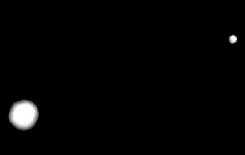
Neptune
Neptune is the seventh planet, and the smallest of the giant gas planets. Its magnetic field--like that of Uranus--is a highly tilted 47 degrees from the axis of rotation.Neptune receives only three percent as much sunlight as Jupiter, yet it is a dynamic planet and surprisingly shows several large, dark spots. The largest spot, dubbed the Great Dark Spot, was about the size of Earth and was similar to Jupiter's Great Red Spot, which is a hurricane-like storm. Hubble Space Telescope images reveal that the Great Dark Spot is gone. Neptune has the strongest winds on any planet with winds blowing up to 2,000 km/hr. Most of its winds blow westward, opposite to the rotation of the planet. A small irregularly shaped, eastward-moving cloud "scoots" around Neptune every 16 hours or so; this "scooter" could be a cloud plume rising above a deeper cloud deck.
Neptune has four rings and eight moons. The rings appear to be "ring arcs," or partial rings; however, they actually are complete. The rings vary in thickness so that they cannot be fully viewed from Earth. All eight moons are small and remain close to Neptune's equatorial plane. Triton, the largest satellite of Neptune, is one of the most interesting satellites in the solar system. It shows evidence of a remarkable geologic history, with active geyser-like eruptions spewing invisible nitrogen gas and dark dust particles several kilometers into the tenuous atmosphere. Triton's relatively high density and retrograde orbit offer strong evidence that it is not an original member of Neptune's family, but is a captured object.

Pluto
Pluto is the smallest, coldest, and farthest planet from the Sun, with an orbit that is the most elliptical and tilted. Due to its great distance, Pluto has not been visited by spacecraft. As a result we do not know a great deal about Pluto.We do know that Pluto is very small--smaller than Earth's moon, some 2,330 km across. The planet's surface is slightly reddish, composed of exotic snows of methane, nitrogen, and carbon monoxide. Pluto has polar caps as well as large, dark spots near the equator. Evidence indicates the existence of a rock and water ice interior. Above the surface lies an atmosphere one millionth the density of Earth's. Although the atmosphere is much more tenuous than Earth's, Pluto's low gravity (about 6 percent of Earth's) causes the atmosphere to be much more extended in altitude than Earth's. Because Pluto's orbit is so elliptical, Pluto grows much colder during that part of each orbit when it is far from the Sun. As a result, Pluto's atmosphere is thought to persist only for the part of its orbit when Pluto is closer to the Sun, as it is now.
The moon Charon, which is almost half the size of Pluto, orbits the planet every 6.4 days, at an altitude of about 18,300 km. Given the rough similarity of Pluto's size to Charon's, most planetary scientists refer to Pluto-Charon as a double, or binary, planet. Charon's surface differs from Pluto's; it is covered with dirty water ice and does not reflect as much light as Pluto's surface. Charon's surface is devoid of strong color. To date, scientists have not found evidence to indicate that Charon has an atmosphere.